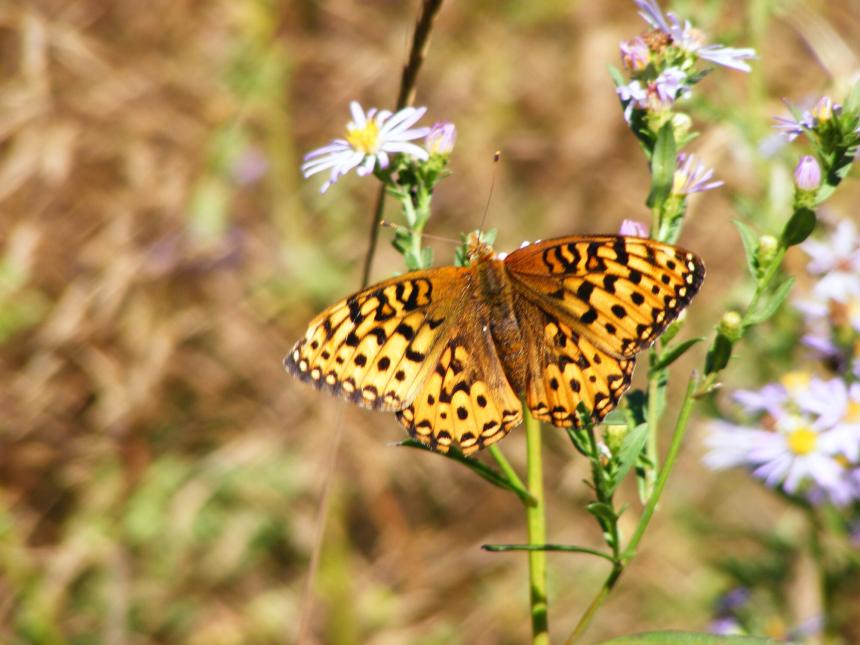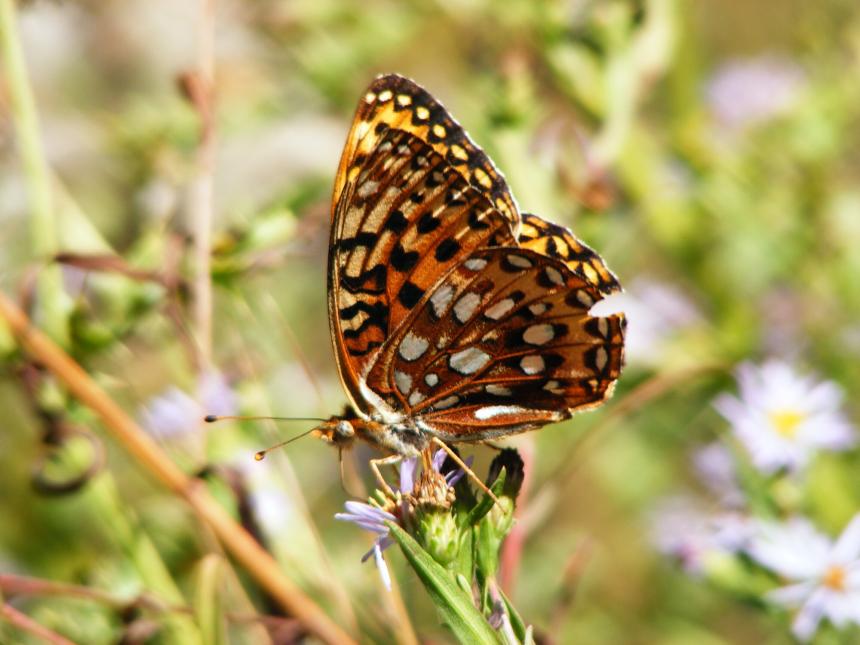Low-
Moderate
The population size of the valley silverspot (bremnerii subspecies) in Washington is critical and is considered to have a declining trend. The butterfly is recognized as a "Species of Greatest Conservation Need" in Washington due to its rare and restricted hostplants and habitat types, small number of isolated populations, limited range and distribution, and known threats to it habitats.
Description and Range
Physical description
The valley silverspot is in the genus Argynni (greater fritillaries). It has distinctive black line and dot patterning on its bright orange upperside, and a heavily-patterned underside with silvery orbs. Wingspan is up to 2.5 inches. Fritillary larvae are generally dark with many bristled spines.
Ecology and life history
The valley silverspot is restricted to native grasslands in western Washington, primarily montane meadows in the northeastern Olympic Mountains, and low-elevation, short-stature grasslands in the south Puget Sound region. In a two-year study of valley silverspot habitat and nectar use on two south Puget Sound prairies, early blue violet was identified as a larval host, and two plants were selected for adult nectar sources (showy fleabane, [Erigeron speciosus] and Canada thistle [C. arvense]). There have been no hostplant or habitat studies in Olympic Mountain populations.
Like other greater fritillaries, the valley silverspot complete a single life cycle annually (univoltine). They are sedentary butterflies and do not migrate; instead, the species inhabits sites year-round (as egg, larva, pupa and adult). Adults emerge from their chrysalids (pupae) during species-specific time periods; typically early-to-late summer.
Males begin emergence first, followed by females; late season individuals are primarily or solely females. Weather influences butterfly emergence and flight period duration, with wet or cold conditions potentially delaying emergence.
Male fritillaries seek mates using rapid patrolling and searching flight behavior. Females search for egg-laying sites by slowly flying and hovering above hostplants and then landing and crawling to inspect vegetation before depositing eggs singly.
Both males and females feed by using their long proboscis to sip floral nectar. Research on other Argynni species suggests that nectar availability affects the number of eggs laid by females.
These species depend on violets (genus Viola) for their hostplants. Argynni fritillaries lay eggs late in the summer. A tiny larva hatches within a few weeks and seeks shelter to overwinter, but does not feed until the following spring. Larvae feed nocturnally on their hostplant; this characteristic, along with bristled spines on their dark body and a gland that secretes defensive chemicals, protects them from predators.
Geographic range
The distribution of the valley silverspot is limited in part by their dependence on rare habitat types. Their distribution and abundance in Washington is characterized by low numbers of small isolated populations. Declines in both the number and size of populations have been documented for this species.
Surveys have been conducted to determine the current distribution of the valley silverspot in the south Puget Sound region. Little is known of the current status and distribution of the species in other portions of their range within the state.
The species in Washington has been detected in the following counties: Clallam, Clark, Cowlitz, Jefferson, Lewis, Pierce, and Thurston.
Climate vulnerability
Sensitivity to climate change
Low-
Moderate
There is limited information on valley silverspot sensitivity to climate change, but it is likely sensitive to fire. Valley silverspot prefers open grassland habitat, and its host plant, early blue violet, thrives in early successional landscapes; fire likely helps maintain open grassland habitat by preventing forest succession. However, increasing fire frequency may facilitate the expansion of scotch broom and other invasive plants, which can outcompete violets, reducing host plant availability.
Exposure to climate change
Low-
Moderate
- Altered fire regimes
Conservation
Conservation Threats and Actions Needed
- Invasive and other problematic species
- Threat: Invasive plants, those currently here, and many yet to come in the future, out-compete native grassland species, and otherwise make habitat unsuitable.
- Actions: Using herbicide, fire, and mechanical methods to restore native prairie. Planting/seeding native prairie species.
- Resource information collection needs
- Threat: Incomplete knowledge of this species' distribution in the northeast Olympic Mountains.
- Action: Conduct surveys to determine current status and distribution of populations in the southern Cascade Mountains of Washington.
See the Climate vulnerability section for information about the threats posed by climate change to this species.
Resources
References
Boggs, C. 2003. Environmental variation, life histories, and allocation in Butterflies: Ecology and Evolution Taking Flight. Boggs, C., W. Watt, and P. Ehrlich, eds. The University of Chicago Press. 737pp.
Hays, D., A. Potter, C. Thompson, and P. Dunn. 2000. Critical habitat components for four rare south Puget Sound butterflies. Final report to The Nature Conservancy. Washington Department of Fish and Wildlife. Olympia.
Hietala-Henschell, K., S. Foltz Jordan, S. Jepsen, and E. Scheuering. 2020. Interagency Special Status/Sensitive Species Program (ISSSSP) Species Fact Sheet: Speyeria zerene bremnerii. USDA Forest Service Region 6 and USDI Bureau of Land Management Oregon State Office. 25 pp.
James, D. and D. Nunnallee. 2011. Life Histories of Cascadia Butterflies. Oregon State Univ. Press, Corvallis. 447pp.
Pyle, R.M. and C.C. LaBar. 2018. Butterflies of the Pacific Northwest. Timber Press. 461 pp.
Pyle, R. 1989. Washington butterfly conservation status report and plan. WDFW, Olympia. 216pp.
Schultz, C., E. Henry, A. Carleton, T. Hicks, R. Thomas, A. Potter, M. Collins, M. Linders, C. Fimbel, S. Black, H. Anderson, G. Diehl, S. Hamman, R. Gilbert, J. Foster, D. Hays, D. Wilderman, R. Davenport, E. Steel, N. Page, P. Lilley, J. Heron, N. Kroeker, C. Webb, and B. Reader. 2011. Conservation of prairie-oak butterflies in Oregon, Washington, and British Columbia. Northwest Science 85: 361–388.
USFS-BLM. 2009. Species fact sheet: Valley Silverspot. Prepared by The Xerces Society for Invertebrate Conservation. Portland, Oregon.
Zhang, J., Q. Cong, J. Shen, P. A. Opler and N. V. Grishin. 2020. Genomic evidence suggests further changes of butterfly names. The Taxonomic Report of The International Lepidoptera Survey 8(7):1-41.

